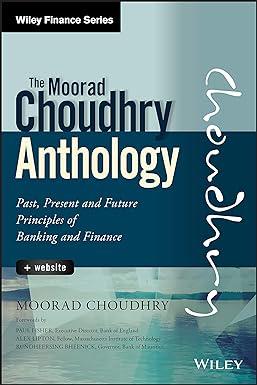Question
We will review the historical financial performance of Amazon. For your analysis, please use: the latest annual (YE 2020) financial statements and report; Hint: you
We will review the historical financial performance of Amazon.
For your analysis, please use: the latest annual (YE 2020) financial statements and report; Hint: you may need to pull additional historical financial statements for some metrics. Please review the 10K in its entirety for background.
Part 1 - Revenue
1. What is the revenue growth rate between 2018 and 2019? What about between 2019 and 2020? What has the 2018-20 Revenue CAGR been?
2. Which sections of the 10K should you review to better understand what was the reason for the revenue trend in between 2019 and 2020? After reviewing, explain what happened.
3. Which revenue segment grew the most? What does it represent?
4. Based on our lecture notes, which company is bigger Apple or Amazon? How would you answer this question in 2018?
Part 2 - Profitability
For the years 2018, 2019, and 2020, calculate:
1. Calculate Gross Margin and COGS Margin
2. Calculate cost margins: fulfillment, technology and content, marketing, SG&A
3. Did cost margins increase or decrease in 2020? Where was the key drivers for each?
4. Calculate Operating Income Margin and EBITDA margin (use Operating income as a starting point to calculated EBITDA)
5. What trend do you see in profitability for Amazon?
Part 3 - Returns
1. Calculate 2019 and 2020 EBIT / Assets (hint1: use operating income in your calculation; hint 2: how many 10K filings would you need for this calculation?)
2. Calculate the 2019 and 2020 ROE
3. How have returns behave between 2019 and 2020? Do the two metrics provide consistent messaging?
4. Is the ROE in line with expectations discussed in class? What approach would you use to better understand whether this figure is high or low for this company? Industry?
5. Is ROE a reliable metric? Why or why not?
Part 4 - Working Capital Ratios
Please calculate the following for 20182020:
1. Accounts Receivable Days of Sales
2. Accounts Payable Days of COGS
3. Inventory Days of Sales
4. Please calculate the following Amazon-specific metric: "The operating cycle is the number of days of sales in inventory plus the number of days of sales in accounts receivable minus accounts payable days"
5. What does the value of this metric show you? Is this good or bad?
6. Calculate the Cash Level Ratio for 201820. Is Amazon being conservative or aggressive with regards to how much cash is keeps on balance sheet compared to rough industry averages?
Part 5 - Leverage Ratios
Calculate the following for 2018-20
1. Debt/Cap
2. Debt/ EBITDA
3. What trend do you see in leverage
Part 6 - Liquidity
For 2018-2020, calculate:
1. Current ratio
2. FCR
Part 7:
Imagine that you're an analyst at a debt fund. You've reviewed the financial performance of the company historically. Please summarize your conclusions / pick the right choices:
Based on historic metrics, the company's performance has been [good / mediocre / bad]. Revenues have been [increasing / decreasing], mainly driven by [elaborate based on your conclusions in part 1] Profitability has been [improving / stable/ worsening] over the last year. Based on the last 3 years, profitability has been [improving / declining / stable] Based on historic metrics, costs to watch for in the future will be [elaborate / suggest looking at costs that provide a larger contribution] Over the same time, working capital ratios have been [improving / worsening], which is especially evident from the operating cycle metric [elaborate how] At the same time, cash levels are [adequate/ inadequate]. Leverage has been [increasing / declining / stable]. Liquidity is currently [a concern / not a concern].
Extra credit: based on your review, what are the key metrics that drive Amazon's story and its success. What will Amazon need to continue to do to maintain this trajectory?
Step by Step Solution
There are 3 Steps involved in it
Step: 1

Get Instant Access to Expert-Tailored Solutions
See step-by-step solutions with expert insights and AI powered tools for academic success
Step: 2

Step: 3

Ace Your Homework with AI
Get the answers you need in no time with our AI-driven, step-by-step assistance
Get Started


